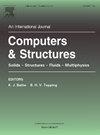协同方法:用于高效点蚀模拟的周动力学和机器学习回归方法
IF 4.4
2区 工程技术
Q1 COMPUTER SCIENCE, INTERDISCIPLINARY APPLICATIONS
引用次数: 0
摘要
腐蚀引起的材料劣化对结构的完整性构成了普遍威胁,因此有必要深入了解其复杂的行为。点蚀是这方面的一个关键问题,它加速了材料的退化。传统模型的局限性在于忽略了溶解过程中的次表层电极边界层动力学。在本研究中,我们提出了一种新颖的方法,它将周动力学(PD)扩散框架与机器学习(ML)技术相结合,开发出一种高效的预测模型,并提高了计算效率。所提出的 PD-ML 混合模型利用了 Peridynamics 固有的非局部效应和机器学习的模式识别能力。该模型在特定材料点的浓度值和其空间范围内相关成分的浓度之间建立了分析联系,并考虑了所应用的外部质量通量。该模型的适应性是通过多元线性回归确定的加权回归系数实现的。根据实验和传统的 PD 模型进行验证,证明了该模型在不同微扩散情况下的精度和效率。对于一维均匀腐蚀和二维点状腐蚀情况,我们的混合模型可以得出精确的浓度预测结果,同时与传统方法相比,计算速度有了显著提高。具体来说,混合模型实现了令人印象深刻的提速,每个时间步约快 4 倍,整体模拟快 2.5 倍。这项研究为预测实际系统中由腐蚀引起的材料劣化提供了一种前景广阔的工具,不仅准确、高效,而且具有更广泛的应用潜力。本文章由计算机程序翻译,如有差异,请以英文原文为准。
Synergistic approach: Peridynamics and machine learning regression for efficient pitting corrosion simulation
Corrosion-induced material deterioration poses a pervasive threat to structural integrity, necessitating an in-depth understanding of its intricate behaviors. Pitting corrosion, a critical concern in this context, accelerates the degradation of materials. The limitations of conventional models arise from their neglect of the subsurface electrode boundary layer dynamics during the dissolution process. In this study, we present a novel approach that combines Peridynamics (PD) diffusion framework with machine learning (ML) techniques to develop an efficient predictive model and computational efficiency. The proposed hybrid PD-ML model leverages the non-local effects inherent to Peridynamics and the pattern recognition capabilities of machine learning. It establishes an analytical connection between the concentration value at a specific material point and the concentrations exhibited by related constituents within its spatial horizon, considering the external mass flux applied. The adaptability of the model is achieved through the utilization of weighted regression coefficients, determined via multivariate linear regression. Validation against experiments and conventional PD model demonstrates the model's precision and efficiency using diverse micro-diffusivity scenarios. For 1D uniform and 2D pitting corrosion cases, our hybrid model yields precise concentration predictions while showcasing a remarkable improvement in computational speed compared to conventional approaches. Specifically, the hybrid model achieves an impressive speedup, approximately 4 times faster per time step and 2.5 times faster overall simulation. The study presents a promising tool for predicting corrosion-induced material deterioration in practical systems, offering accuracy, efficiency, and potential for broader applications.
求助全文
通过发布文献求助,成功后即可免费获取论文全文。
去求助
来源期刊

Computers & Structures
工程技术-工程:土木
CiteScore
8.80
自引率
6.40%
发文量
122
审稿时长
33 days
期刊介绍:
Computers & Structures publishes advances in the development and use of computational methods for the solution of problems in engineering and the sciences. The range of appropriate contributions is wide, and includes papers on establishing appropriate mathematical models and their numerical solution in all areas of mechanics. The journal also includes articles that present a substantial review of a field in the topics of the journal.
 求助内容:
求助内容: 应助结果提醒方式:
应助结果提醒方式:


